Cast the fly across the rip and allow it to quarter
with the current. Retrieves can be one handed or two
handed but are usually quite fast. The strong sihouette
presented by the dark fly makes it very visible against
the sky. Hang on, as the take is usually so strong
that you'll think that the first fish you connect with
is much larger than it turns out to be.
The Eyed Snake Fly
Hook: Mustad 34007 or similar, sizes 6 to 3/0.
Thread: Black monocord or similar.
Tail: Black dyed ostrich herl and, optionally,
black Krystal Flash.
Head: Black dyed deer hair, spun and clipped.
Eyes: Lead, White with black pupil, sized to hook.
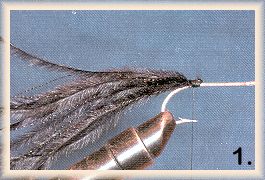
1. Start the thread just forward of the hook bend and
tie in 6-10 strands of ostrich herl to the length desired
(4-8 black dyed saddle hackles can be substituted). The
additional 3-6 strands of Krystal Flash is optional.
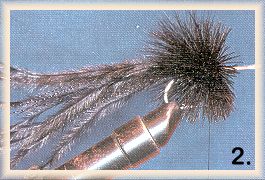
2. Select a small bunch of deer hair and cut it from
the patch. Clean out the underfur and trim the butts
even. Spin this bunch of hair just forward of where the
collar was tied in. The idea is to let the tips of the
hair extend back over the tie-in point as a collar.
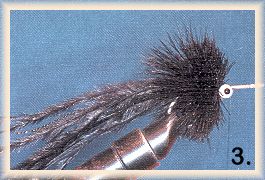
3. Gauge the distance to the hook eye at this point.
Depending on how well you spin deer hair, you may want
to put another bunch on at this point. In any case, you
want to attach the lead eyes about the halfway point between
the collar and the hook eye. Secure the eyes under the hook
shank with figure eight wraps of thread and add a drop of
Zap-a-Gap or similar glue.
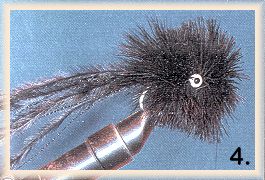
4. Select more deer hair and prepare it for spinning. Spin
the hair in front of the eyes. One trimmed from the patch,
trim both the tips and butts. This will reduce the amount
of trimming required on. Repeat with bunches of hair
until you reach the hook eye. Unlike a regular bass bug,
you don't need to pack the hair to extreme density - it can
be a little loose. Tie off the thread and coat with head
cement.

5. To trim the fly, hold it by the hook bend with the
point up and the eye pointing at you. Trim the bottom
flat. This will maxamize the available hook gap. Turn
the fly over and trim the sides and top to a rough
cylinder shape. Leave the tips from the first bunch of
hair pointing towards the hook bend. I also taper the
front a little. To reinforce thing, dab a little thin
lacquer on the underside of the head next to the hook
shank. The finished fly looks very appealing with the
eyes poking out from the fur.
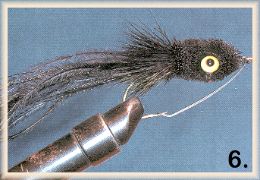
The Eyed Snake Fly has applications in fresh water.
In smaller sizes, it will catch large bass and walleye.
In larger sizes, it will do a number on pike and muskie.
Keep several patterns on hand if you're going after
toothed prey. The fly won't stand up for long, but the
good news is that it is easily repaired, for all you
usually need to do is tie in a new tail. ~ Sheldon Seale
Our Man In Canada Archives

